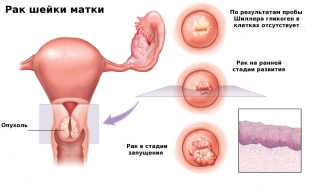Cervical cancer is a widespread oncological pathology. Young women of reproductive age are exposed to this disease, which is directly related to the high prevalence of human papillomavirus infection among women of this age group. Since cervical cancer and human papillomavirus infection can be asymptomatic for a long time, and are diagnosed already in the last stages, it is the diagnostic process that determines the success of subsequent treatment. Timely detection and elimination of pathological changes in the cervix is the best method for preventing this oncopathology. About the main methods of diagnosis and treatment of cervical cancer tells estet-portal.com.
Methods for the prevention, diagnosis and treatment of cervical cancer
The diagnostic process of cervical cancer includes several types of special gynecological research methods that help determine the extent of the pathological process, its nature and prevalence. Treatment for cervical cancer depends on the stage at which the disease was diagnosed. Timely diagnosis and treatment of papillomavirus infection, which causes atypical changes in the epithelium of the cervix, can be attributed to the main preventive measure that helps prevent the development of cervical cancer.
Cervical Cancer Treatment:
- methods for diagnosing cervical cancer;
- cervical cancer treatments;
- Cervical cancer prevention methods.

Methods for diagnosing cervical cancer
During the initial examination, a gynecological examination of the cervix in the mirrors provides important information for the diagnosis of cervical cancer. On the cervix, cauliflower-like growths are visualized, which may be whitish, gray-pink or red. When touched, they are easily destroyed and bleed. If the tumor grows into the cervical canal, the cervix is barrel-shaped, has a bumpy surface and a pink-marble color. During colposcopy, pathological vessels, changes in the color of the pathological focus are visualized, the specific Schiller test will be negative for cervical cancer. Cytological examination indicates atypia of epithelial cells. Additional research methods such as CT, MRI, angio- and lymphography help to establish the presence of distant metastases.
Cervical Cancer Treatment
The treatment of cervical cancer depends on the stage of the malignant process in the patient:
- at stage 1A, the patient is recommended surgical treatment: high amputation of the cervix or extirpation of the uterus with tubes. Next, radiation therapy is carried out;
- at stages 1B and 2A, Wertheim's operation and combined radiation therapy are performed;
- at stages 2B, 3A and 3B, only combined radiation therapy is recommended;
- at stage 4, the treatment of cervical cancer involves palliative therapy, with distant metastases, chemotherapy with cystplatin is possible.
Cervical Cancer Prevention Methods
Prevention of cervical cancer involves, first of all, warning patients about the danger of papillomavirus infection and the need for timely preventive examinations in the gynecological office. To date, there are vaccines against papillomavirus infection, a single administration of which protects the patient from the papillomavirus throughout her life. If the patient still has papillomavirus infection and cervical dysplasia, it must be treated as soon as possible. For this purpose, conservative and surgical methods of treatment are used. Timely detection of background and precancerous diseases of the cervix and their elimination will help protect the patient from the development of cervical cancer.






Add a comment